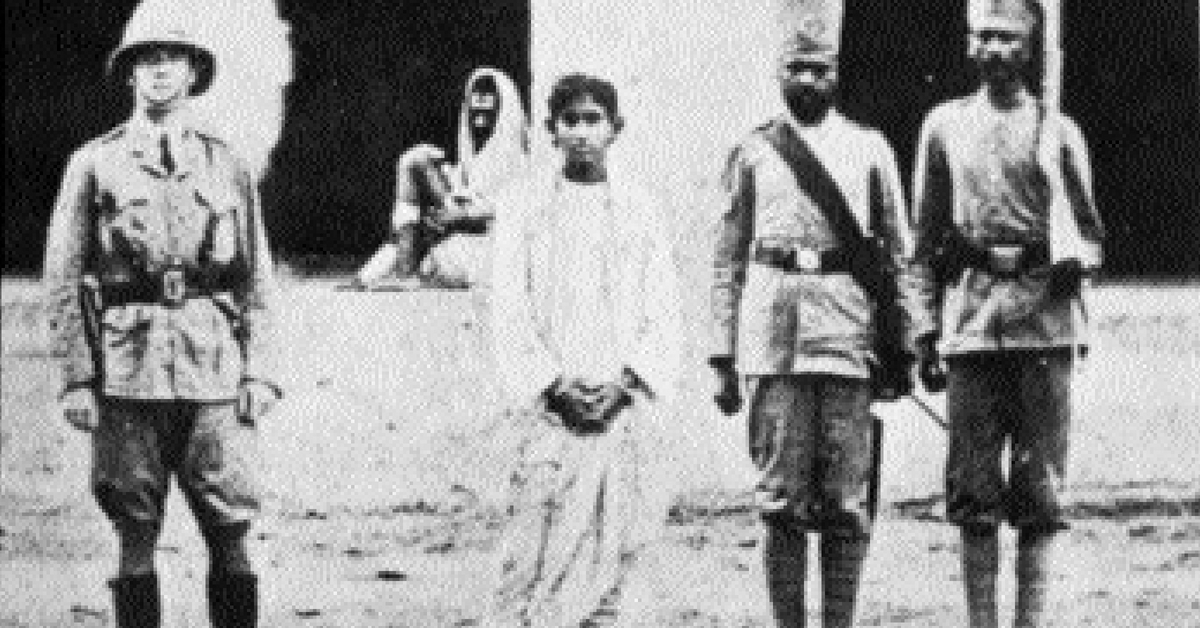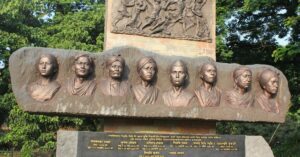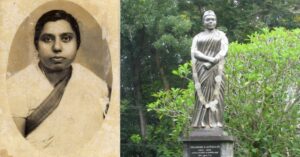Khudiram Bose, the ‘Boy Revolutionary’ Who Died With a Smile on His Face!
Bose was influenced when he was just a boy, and grew up to be a fierce revolutionary who loved his nation.

As the nation approaches its 72nd Independence Day, we bring you stories of #ForgottenHeroes of #IndianIndependence that were lost among the pages of history.
He was only 18 years old when he was sentenced to death for an attack and the subsequent killing of three Britishers in Muzaffarpur, Bihar, in 1908. A century has passed, yet, Khudiram Bose’s name remains in the shadows.
One of the youngest revolutionaries of the Indian freedom struggle, he was hung on August 11, 1908, when he was just 18 years old. (Well 18 years, eight months and eight days old, to be exact.)

The early life of a revolutionary:-
Born on December 3, 1889, in the small village of Habibpur situated under the Keshpur Police Station in the Midnapore district of West Bengal, Khudiram was the son of a Tehsildar, the fourth child in a family of three daughters.
Life was difficult for young Khudiram from the start, when he lost his mother at six, and his father, a year later. Cared for by his elder sister, he lived in her house at Hatgachha village, and attended the Hamilton High School.
The revolutionary seed is sown:-
Khudiram was possessed by the spirit of the freedom movement when he heard a series of public lectures held in Medinipur, by Sri Aurobindo and Sister Nivedita. He became a volunteer when he was just 15, and courted his first arrest for distributing pamphlets against the British rule in India.
Just a year later, Khudiram was taking part in full-blown revolutionary activities, planting bombs near police stations and targetting government officials.
It is said that Khudiram was part of the Anushilan Samiti, a Bengali organisation that was active in the first quarter of the 20th century, propounding revolutionary violence as a means to driving the British out of India.
During the British rule, the Samiti was led by nationalists like Aurobindo Ghosh, and his brother, Barindra Ghosh.
The Kingsford revenge:-
During this period, the Chief Presidency Magistrate of Calcutta was Douglas H Kingsford. Infamous for handing out strong and harsh punishments to freedom fighters, he was a target of the revolutionaries. He was particularly vindictive towards anti-partition and swadeshi activists.
However, it was one incident that made Kingsford put a target on his own back. The case of Aurobindo Ghosh, the editor of Bande Mataram, and its publisher, Bipin Chandra Pal.
A 15-year-old youngster, Sushil Sen, had opposed the cruelty of cops beating revolutionaries assembled before the court, and Kingsford ordered 15 lashes for the boy. With every lash, Sen shouted ‘Vande Mataram’. This news was widely published in the press, and when the revolutionaries read this news, they boiled with anger and decided that only revenge was the best medicine for Kingsford.
However, the British Government caught wind of the plan, and transferred Kingsford to Muzaffarpur, hoping that the anger of the revolutionaries in Calcutta would subside. The revolutionaries heard about this plan and prepared to kill Kingsford at Muzaffarpur.
This was going to be a tough mission, and only a trustworthy assassin could be used. The folks in charge decided to appoint Prafulla Kumar Chaki, and Khudiram Bose, who readily agreed.
A mission underway:-
The two young revolutionaries reached Muzaffarpur in the third week of August 1908, and adopted the aliases ‘Haren Sarkar’ and ‘Dinesh Roy’. They decided to carry out spy missions, trying to learn about Kingsford’s routine, attempting to find a loophole when the attack could be carried out.
The two lads stayed at the Dharamshala of Bihari zamindar, Parmeshwar Narayan Mahato, and got to work. They soon got a good idea of Kingsford’s routine, his timings at court, the European Station Club, and his house.
They decided that Kingsford could be attacked when he left the club at 8:30 pm. This would give the duo the chance to carry the hit-out at night. It was decided that a bomb would be used.
There are many accounts to describe the actual course of events. However, it is widely believed that Prafulla and Khudiram attacked Kingsford’s carriage when it was leaving the club. As the horse carriage approached, Khudiram hurled a bomb at it.
An explosion followed, and the hit was a success! The carriage blew up and burst into flames. Prafulla and Khudiram, believing they had succeeded, melted into the darkness.
The aftermath:-
News of the attack spread. Everyone was aware of the incident by midnight, and police were on the lookout for suspects. Khudiram, meanwhile, had continued running, and after doing so all night, reached a station called ‘Waini’, tired and exhausted after 25 miles on foot.
He reached a tea-stall and asked for water. He was confronted by a couple of constables, who immediately suspected him, seeing that he was perspiring and exhausted. They asked him a few questions and decided to detain him, once their suspicions grew. The interrogation turned physical, with Khudiram struggling to run, and the cops apprehending him.
In the melee, a revolver fell out. The constables then searched Khudiram’s belongings and found cash, a railway map and timetable, and several rounds of ammunition.

Now, the young revolutionary’s fate was sealed.
A mistake in hindsight:-
Khudiram and Prafulla had thrown a bomb at a carriage, but sadly, it wasn’t Kingsford’s carriage. It was occupied by Mrs Kennedy, the wife of Pringle Kennedy, a leading pleader of the Muzaffarpur Bar, and her daughter. Both women lost their lives in the attack, within hours of each other.
Khudiram pays with his life:-
Apprehended by the policemen and consequently handcuffed, Khudiram was brought to the district magistrate, Mr Woodman. It must be noted that Prafulla had taken a different escape route, and was ultimately caught. However, he shot himself in the mouth before cops could get hold of him.
Unaware of Prafulla’s death, Khudiram Bose assumed full responsibility of the Muzaffarpur bombings in front of the district magistrate. He was then put on trial.
The trial started on 21st May 1908, and Bose, along with two others, faced the panel. Some lawyers took up Khudiram’s case, purely out of love for the country.
On 23rd May, Khudiram resubmitted his statement to the magistrate, denying any responsibility for the attack. However, that would be in vain, as the judge would ultimately sentence him to death.
A martyr hangs:-
On being read out the verdict, Khudiram Bose smiled, prompting the judge to ask him whether he understood the full extent of his punishment. Bose was cheeky and replied that not only had he understood the verdict, he was also ready to teach the judge bomb-making if given the time.
There was still hope, as Khudiram had a week to appeal to the High Court. Khudiram initially refused, but after persuasion from his counsellors, agreed to appeal.
The High Court hearing took place on July 8th. Represented by Narendrakumar Basu, Khudiram challenged the verdict of the court. Basu argued spiritedly, bringing in pertinent points, highlighting the fact that Prafulla had shot himself–an indicator that perhaps he was the guilty one, throwing the bombs.
The British judges announced the final verdict on July 13th, 1908. Khudiram’s appeal was dismissed, and the British judges confirmed his conviction. An order was issued to carry out a death sentence before 11th August.
On the fateful day, the area near the prison was swelling with crowds, holding flower garlands. Khudiram reportedly walked up to the gallows confidently and was hung shortly after. His funeral procession went through Kolkata and was full of people offering flowers to his body.
At the tender age of 18, Khudiram was hung. His death sparked fervour among revolutionaries, who heaped honours upon him. The poet, Pitambar Das, wrote a song that resonated the passion that Khudiram had for his motherland.
You may also like:- The Untold Story of ‘Satyananda’, the Only American to Join India’s Fight for Freedom
Let us not forget the ones who were instrumental in giving us the great nation we know today. This Independence Day, remember the sacrifice of an 18-year-old, who gave up his life for his motherland.
(Edited by Shruti Singhal)
Like this story? Or have something to share? Write to us: [email protected], or connect with us on Facebook and Twitter.
This story made me
- 97
- 121
- 89
- 167
Tell Us More
We bring stories straight from the heart of India, to inspire millions and create a wave of impact. Our positive movement is growing bigger everyday, and we would love for you to join it.
Please contribute whatever you can, every little penny helps our team in bringing you more stories that support dreams and spread hope.



















